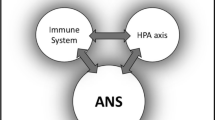Summary
-
1.
Gel filtration of tissue homogenates fromHelix aspersa separates cardioactive agents into four peaks of activity. One peak inhibits an isolated heart ofHelix, the remaining three are excitatory.
-
2.
Elution characteristics, enzymatic sensitivity, and pharmacological properties indicate that the active principle of the inhibitory peak is acetylcholine, while that of one of the excitatory peaks is 5-hydroxy-tryptamine.
-
3.
The two remaining peaks lose their activity when incubated with Pronase, trypsin, or chymotrypsin. This indicates that the active substances in these peaks are peptides.
-
4.
The active substance of one of these peaks has an apparent molecular weight of ca. 700, and has been termed small cardioactive peptide(s) (SCP). Its presence is essentially confined to the nervous system and it does not appear to play a physiological role in control of the heart.
-
5.
The other peptide cardioexcitor had an apparent molecular weight of ca. 7000, and was termed large cardioactive peptide(s), (LCP). It is found primarily in the sub-esophageal ganglia, several nerve trunks, the hemolymph, and in particularly high concentrations in the auricle.
-
6.
Kinetic and pharmacological results suggest that LCP uses a different receptor in theHelix heart than does 5-HT.
-
7.
It was concluded that LCP demonstrates several of the characteristics expected of a cardioactive neurohormone.
Similar content being viewed by others
Abbreviations
- LCP:
-
large cardioactive peptide(s)
- SCP:
-
small cardioactive peptide(s)
References
Agarwal, R.A., Greenberg, M.J.: A comparative study of cardioactive agents from bivalve tissue. Comp. Biochem. Physiol.31, 835–850 (1969)
Boer, H.H., Joose, J.: Endocrinology. In: Pulmonates. Fretter, V., Peake, J. (eds.), Vol. 1, pp. 245–308. New York: Academic Press 1975
Cottrell, G.A.: Separation and properties of sub-cellular particles associated with 5-hydroxytryptamine, with acetylcholine, and with an unidentified cardio-excitatory substance fromMercenaria nervous tissue. Comp. Biochem. Physiol.17, 891–907 (1966)
Cottrell, G.A., Osborne, N.: A neurosecretory system terminating in theHelix heart. Comp. Biochem. Physiol.28, 1455–1459 (1969)
Frontali, N., Williams, L., Welsh, J.H.: Heart excitatory and inhibitory substances in molluscan ganglia. Comp. Biochem. Physiol.22, 833–841 (1967)
Gersch, M., Deuse, R.: Über herzaktive Faktoren aus dem Nerven-system von Aplysia. Zool. Jb., Allg. Zool. Physiol.68, 519–534 (1960)
Hampe, M.M.V., Tesch, A., Jaegar, C.P.: On the nature of the cardioactive substances fromStrophocheilus oblongus ganglia. Life Sci.8, 827–835 (1969)
Jaegar, C.P.: Neuroendocrine regulation of cardiac activity in the snail,Strophocheilus oblongus. Comp. Biochem. Physiol.17, 409–415 (1966)
Janson, J.C.: Adsorption phenomena on Sephadex. J. Chromatogr.28, 12–20 (1967)
Kerkut, G.A., Cottrell, G.A.: Acetylcholine and 5-hydroxytryptamine in the snail brain. Comp. Biochem. Physiol.8, 53–63 (1963)
Kerkut, G.A., Laverack, M.S.: A cardio-accelerator present in tissue extracts of the snail,Helix aspersa. Comp. Biochem. Physiol.1, 62–71 (1960)
Kerkut, G.A., Meech, R.W.: The internal chloride concentration of the H and D cells in the snail brain. Comp. Biochem. Physiol.19, 819–832 (1966)
Liebeswar, G., Goldman, J.E., Koester, J., Mayeri, E.: Neural control of circulation inAplysia. III. Neurotransmitters. J. Neurophysiol.38, 767–779 (1975)
Loveland, R.E.: 5-hydroxytryptamine, the probable mediator of excitation in the heart ofMercenaria (Venus) mercenaria. Comp. Biochem. Physiol.22, 95–104 (1963)
Meng, K.: Untersuchungen zur Steuerung der Herztätigkeit beiHelix pomatia L. Zool. Jb.68, 539–566 (1960)
Price, D.A., Greenberg, M.J.: Structure of a molluscan cardioexcitatory peptide. Science197, 670–671 (1977)
S.-Rózsa, K., Perényi, L.: Chemical identification of the excitatory substance released inHelix heart during stimulation of the extracardial nerve. Comp. Biochem. Physiol.19, 105–113 (1966)
Welsh, J.H.: Neurohormonal regulation and the control of the molluscan heart. Comp. Gen. Pharmacol.2, 423–432 (1971)
Welsh, J.H., Taub, R.: Structure-activity relationships of acetylcholine and quaternary ammonium ions. J. Pharmacol. Exp. Ther.99, 334–342 (1950)
Wright, A.M., Moorhead, M., Welsh, J.H.: Actions of derivatives of lysergic acid on the heart ofVenus mercenaria. Br. J. Pharmacol.18, 440–450 (1962)
Author information
Authors and Affiliations
Additional information
I wish to thank Professors L.M. Riddiford, J.W. Truman, and A.O.D. Willows for critical reading of the manuscript. The research was supported by NSF grant BN575-13597A02 to A.O.D. Willows.
Rights and permissions
About this article
Cite this article
Lloyd, P.E. Distribution and molecular characteristics of cardioactive peptides in the snail,Helix aspersa . J. Comp. Physiol. 128, 269–276 (1978). https://doi.org/10.1007/BF00656860
Accepted:
Issue Date:
DOI: https://doi.org/10.1007/BF00656860




